ARCHIVED – Review of offshore drilling in the Canadian Arctic
This page has been archived on the Web
Information identified as archived is provided for reference, research or recordkeeping purposes. It is not subject to the Government of Canada Web Standards and has not been altered or updated since it was archived. Please contact us to request a format other than those available.
The past is always present
Review of Offshore Drilling in the
Canadian Arctic
Preparing for the future
December 2011
Copyright/Permission to Reproduce
Review of offshore drilling in the Canadian Arctic [PDF 7075 KB]
Table of Contents
Table of Contents
Chapter 1: Why review Arctic offshore drilling?
The National Energy Board (NEB or Board) is the federal body responsible for regulating offshore drilling in the Canadian Arctic. It’s our job to make sure that any company who wishes to drill in this area has plans that are safe for the public, workers, and the environment. If the company can’t provide these, they can’t drill.
Through the spring and summer of 2010, people around the world watched in disbelief as the Deepwater Horizon spilled millions of barrels of oil into the Gulf of Mexico. How could this happen? Is it possible to safely drill offshore while protecting the environment? What do we do when things go wrong? What can we learn from accidents like the Deepwater Horizon?
Within days of the blowout in the Gulf of Mexico, we announced that we would review safety and environmental requirements for offshore drilling in the Canadian Arctic.
As part of the Arctic Review, we wanted to listen to people who live in the North and who would be most affected by Arctic offshore drilling. In the summer of 2010, we decided to hold community meetings across Yukon, the Northwest Territories, and Nunavut to hear people’s views.
At about the same time, the snow geese were arriving back in the Mackenzie Delta after their 5,000 kilometre migration north. Snow geese spend the summer in the North. In the fall, they migrate south, many to the Gulf of Mexico, where they eat the same tubers, roots, and grasses that were now coated in oil from the blown-out Macondo well. Snow geese are a major source of food for some Northern residents. In many Northern communities, the cost of living is high and some residents told us that up to 70 percent of their food comes from the land and the ocean. Now they had to ask themselves if the geese were still safe to eat. Would the geese be contaminated with oil? How would this affect Northern livelihoods?
If there were to be an accident like the Deepwater Horizon in the Canadian Arctic, some people told us they would not be able to provide for their families and could starve, even if there was financial compensation. The people that we met at the community meetings in the North reminded us that, when it comes to the ocean, everything is connected. They told us that, not only would they be affected by any future offshore drilling in the Canadian Arctic, they were concerned that they might already be affected by the incident in the Gulf of Mexico. We heard that any confidence some communities may have had in industry’s ability to safely drill offshore was reset to “square one” by the Gulf of Mexico incident.
We also heard that Northern residents are deeply connected to the land and to the ocean. They told us that being out on the land is like being at home. They have been taught by their Elders that, if you take care of the land, the land will take care of you. In Sachs Harbour, Northwest Territories, one meeting participant told us about a discussion she had with an Elder. He held out a $10 bill and asked her, “can you eat this?”.
We heard that, if there was a drilling accident in the Arctic offshore, life in the North could change irrevocably. In Aklavik, Northwest Territories, local high school students told us that they have learned from going out on the land with their parents and grandparents. “If something happens to the land and ocean, how will we teach our own children?” They told us that even if the animals and whales eventually recovered from an offshore spill, the harvesting skills that are passed down from generation to generation would be lost.
“... we have a fundamental responsibility to review the lessons learned from the Deepwater Horizon accident in the Gulf of Mexico ... The basic attitude of a safety regulator is that you always want to learn from accidents anywhere in the world ... In the coming weeks and months, we will look at the events that transpired, and why they happened and how this kind of accident can be prevented.”
Gaétan Caron, National Energy Board Chair
House of Commons Standing Committee on Natural Resources, 13 May 2010

“... how can you put a dollar figure on what we have and what we could lose?”
COMMUNITY MEETING ATTENDEE,
Clyde River, Nunavut
People at the community meetings reminded us of the unique environment where they live. There are changing ice conditions, strong currents, stretches of 24-hour darkness, extreme cold, and high winds. They have lived with this all their life but they are not sure the harshness is truly understood and being taken into account by companies that want to drill in the Canadian Arctic. They told us that the safety of the workers in this environment would be very important.
While they were very concerned about the potential hazards of Arctic offshore drilling, many people recognized that energy is something we all need. They use gas and oil to fuel their snowmobiles and boats to go hunting and fishing and to run their trucks. In Inuvik, Northwest Territories, one man told us that he knows energy is needed but he has to be able to look at his children and his grandchildren. If development does go ahead, it has to be done right. What would he say to his children and grandchildren if he allowed offshore drilling to happen and their way of life was destroyed?
People attending community meetings talked about their land and environment and told us personal stories about past offshore drilling projects that occurred in the Beaufort Sea hunting ground. In the 1970s and 1980s, operators drilled 93 wells in the Beaufort Sea and another 40 wells in offshore areas near the Arctic Islands. Some of the attendees had worked in offshore drilling or had family members who worked in the industry. We heard concerns about waste that was left behind and spills and discharges that were not cleaned up properly. Some were afraid to speak up when they saw unsafe practices because they were afraid of losing their jobs. A resident of Pond Inlet, Nunavut told us that, in the past, “when inspectors are coming things get cleaned up and then when they leave things go back to the old ways”. They told us that some of the practices that were common when offshore drilling first got underway are no longer acceptable today.
John Amagoalik from Nunavut currently works with the Qikiqtani Inuit Association. He is a past president of Inuit Tapiriit Kanatami and the past chair of the Nunavut Implementation Committee. Dr. Amagoalik spoke of his experiences with previous offshore drilling in the Canadian Arctic:
As you know, most of this exploration in the Canadian Arctic mostly occurred in the Beaufort Sea and in the High Arctic Islands. Some oil and a lot of natural gas were found. This did not lead to development extraction of the resources because it was not economically feasible at the time ... Because the Inuit organizations were not in place, very little information was passed on to Inuit, and monitoring of the exploration was almost non-existent. It was only years later that Inuit began to see the damage the oil companies had done in the High Arctic.
What Happened to the Deepwater Horizon?
When the sun came up over the Deepawater Horizon on 20 April 2010, the rig was floating 4,992 feet (1,522 metres) above the bottom of the ocean. The crew had drilled through 2 1/2 miles (4,000 metres) of sea floor to reach a reservoir of oil and gas in the Gulf of Mexico.
After months of drilling, the Macondo well was in the final stages of completion. The crew had only to test the well to make sure it wasn’t leaking, secure it for temporary abandonment, and move on to the next job.
However, sometime after 9:30 p.m., the tool pusher reported that “they were getting mud back.” Minutes later, a combination of drilling mud, seawater, and flammable methane gas erupted from the well and an explosion rocked the Deepwater Horizon.
Eleven people died in the incident and another 16 were injured.
The Deepwater Horizon burned for two days before sinking on 22 April. However, it would be 12 weeks before crews plugged the well and stopped the worst oil spill in the history of the United States. By the time it was over, approximately five million barrels of oil had leaked into the Gulf of Mexico. Oil coated more than 650 miles (1,046 kilometres) of coastline. By 1 November 2010, responders had collected 8,138 birds, 1,144 sea turtles, and 109 marine mammals affected by the spill.
We heard that there is a need for accountability by all, including industry and regulators.
We listened carefully to the voices telling us that we were not only accountable to Northern residents and to all Canadians, but we also had a great responsibility to the North itself. At the Roundtable in Inuvik, Amie Charlie, a Grade 12 student at Samuel Hearne Secondary School, said "I realize that the National Energy Board has the authority to approve or deny deep-sea explorations in Canada and with this authority comes great responsibility ...". Another meeting attendee reminded us that we had a big decision to make; if we allowed Arctic offshore drilling to proceed, we would be held responsible if anything were to go wrong. A resident from Tuktoyaktuk, Northwest Territories told us that their way of life is in our hands. One Elder told us that she was scared.
While there are currently no applications for offshore drilling before us, we expect to see such applications in the future. We began this review with the intention of finding the best available information on offshore drilling. Chapter 2 lays out how we conducted the Arctic Review. How we regulate offshore drilling in the Canadian Arctic is described in Chapter 3. We discuss what we have learned from past offshore drilling incidents in Chapter 4 and then look at how to drill safely while protecting the environment in Chapter 5. In Chapter 6, we examine how to respond when things go wrong. Finally, in Chapter 7, we describe how our journey will continue.
Throughout this report, we identify key filing requirements that we expect to be met if and when applications are filed in the future. The complete set of filing requirements is contained in the companion document to this report, Filing Requirements for Offshore Drilling in the Canadian Arctic (Filing Requirements). Our Filing Requirements integrate the requirements identified in the report, supplemented by additional, detailed technical requirements, many of which were taken from the Calls for Information we issued during Phase 1 of the Arctic Review. During the Roundtable discussions, industry participants told us that they are willing to answer the kinds of questions found in our Calls for Information.
Chapter 2: How did we gather information about offshore drilling?
Months before the Deepwater Horizon even arrived in the Gulf of Mexico to begin drilling the Macondo well, we had been examining some of the technical issues associated with Arctic offshore drilling. In late 2009, Imperial Oil Resources Ventures Limited applied to the NEB for an advance ruling on its plan for managing an offshore well, should it go out of control.
Instead of ruling on Imperial Oil Resources Ventures Limited’s plans, we decided to conduct a review of the policy for same season relief well capability calling it “an issue of significant public concern”. As part of the hearing to look into this issue, we had planned a technical conference for June 2010 in Inuvik, Northwest Territories.
However, on 11 May 2010, just days after the incident in the Gulf of Mexico, we cancelled the technical conference and the associated hearing and initiated a review of safety and environmental requirements for Arctic offshore drilling. We called it the Arctic Offshore Drilling Review.
In June 2010, we released a draft scope of topics for the Arctic Review so the public could provide their feedback. We heard from more than 60 groups and individuals, including Northern residents, scientists, governments, other regulators, environmental non-government organizations, labour, and industry. We carefully considered these comments and used them to adjust the scope of the Arctic Review.
In their comments, people told us they were concerned about what would happen if there was an oil spill in the Arctic Ocean. Could an incident like the Deepwater Horizon happen in the Canadian Arctic? How would Canada respond if it did? Many people also told us about the unique Arctic environment and said there needed to be more equipment and infrastructure in the North for responding to an oil spill.
Some of the comments related to offshore drilling in Canada’s Atlantic Ocean and in neighboring countries. Others said that we should ban offshore drilling altogether. We did not include these comments in the scope of the Arctic Offshore Drilling Review because they are outside the National Energy Board’s mandate. However, we posted all these comments on our public website so they may be used by others as they see fit.
People asked who would pay for cleaning up an oil spill. To help the public understand this issue, we prepared a backgrounder on financial responsibility and liability and posted it on our website.
“It’s important to have this discussion in the North where you are deeply connected to the land and the sea.”
Kenneth Bateman, National Energy Board Member

“When you look at the Inuvialuit timeline, we were here for a thousand years. When exploration happens ... and the oil is extracted and long after, we’re still going to be here and we’re still going to need our natural resources.”
Darrel Nasogaluak,
President, Tuktoyaktuk Hunters and Trappers, Tuktoyaktuk, Northwest Territories
Once we had decided which topics to examine, we began to gather the best available information on these topics. We gathered this information in a number of different ways. First, we asked everyone who had registered to participate in the Arctic Review to send us any information they thought the Board should consider.
We also sent out two sets of questions for Arctic Review participants. The first set of questions was released on 30 September 2010 and the second on 23 November 2010. These questions, or Calls for Information, asked participants to provide information and expertise about the topics included in the Arctic Review scope. In response to these requests, we received thousands of pages of information which are posted on our website.
The United States government’s Report to the President: National Commission on the BP Deepwater Horizon Oil Spill and Offshore Drilling was very important to the Arctic Offshore Drilling Review. We studied this report along with a number of other reports on the BP Macondo incident and other incidents like it, to see what we could learn. You can find links to these reports on our website.
We also asked participants to suggest topics they thought we should study and to recommend experts to carry out these studies. Based on input from participants in the Arctic Review, we asked experts to prepare a number of reports. These reports are posted on our website.
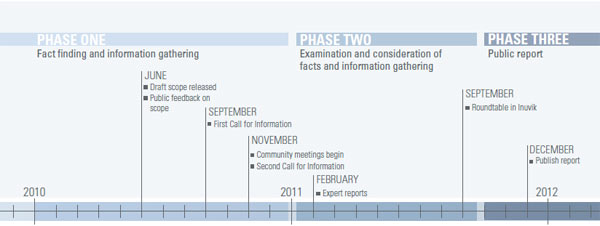
| Phase one Fact finding and information gathering |
Phase two Examination and consideration of facts and information gathering |
Phase three Public report |
|---|---|---|
June 2010
|
February 2011
|
December 2011
|
September 2010
|
September 2011
|
|
November 2010
|
Scope of the Arctic offshore drilling review
- 1. Drilling safely while protecting the environment:
- Potential hazards and risks associated with Arctic offshore drilling, including threats to public safety, worker safety, and the environment;
- Identification and the effectiveness of measures employed to prevent and mitigate the risks associated with Arctic offshore drilling, including the use of management systems;
- State of knowledge on the Arctic offshore, including the physical environment, biological environment, and geosciences; and
- Effectiveness and reliability of available well control methods, including consideration of emerging technologies.
- 2. Responding effectively when things go wrong:
- State of preparedness to respond to drilling accidents, spills and malfunctions, including consideration of contingency planning requirements, emergency response planning requirements, infrastructure, equipment, supplies, and training needs;
- Effectiveness and reliability of options for regaining well control, including relief wells;
- The effectiveness and availability of spill containment and clean-up options under Arctic conditions, including tracking methods, recovery technologies, procedures, equipment, and trained personnel;
- Financing spill clean-up, restoration, and compensation for loss or damage; and
- State of knowledge of long-term impacts of a spill on the environment, way of life, and communities in Canada’s Arctic.
- 3. Learnings:
- Lessons learned from accidents, incidents, and emergency response exercises, particularly those relevant to Northern offshore environments.
- 4. Filing requirements:
- Information to be required from an applicant seeking authorization to drill an offshore well.
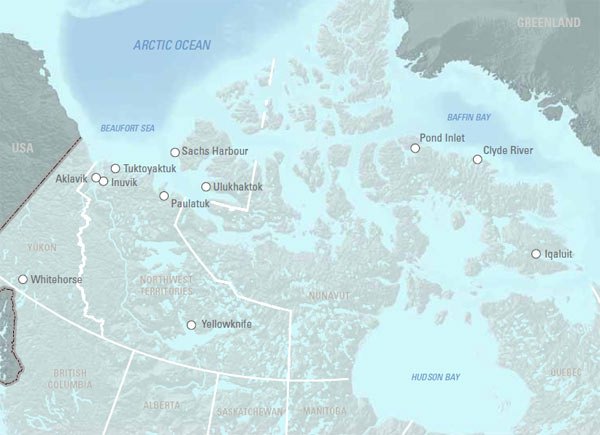
What did we hear at the community meetings?
In addition to examining studies and reports, we wanted to meet face-toface with people and groups interested in Arctic offshore drilling. We felt it was important to listen to the people who would be most affected by Arctic offshore drilling.
Beginning in November 2010, we held more than 40 meetings in 11 communities across Yukon, the Northwest Territories, and Nunavut. We met with Elders, hunters and trappers, community corporation representatives, students, local governments, Northern land claim organizations, territorial governments, and community residents.
The purpose of these meetings was to talk about the role of the National Energy Board and the work we do in the North and to listen to what people had to say about Arctic offshore drilling. It was also an opportunity for people in the North to examine and comment on the facts and information that we had gathered so far.
The people who live in Canada’s Arctic had many questions about offshore drilling, the role of the National Energy Board, and what would happen if Arctic offshore drilling projects went ahead. At many of these meetings, we heard that people understand that energy is important and there is a need for energy development but we cannot let this development occur anywhere at any cost. It must be done the right way.
From the filing requirements
2.2.1 Unique Arctic environment
Provide sufficient detail in the project description to demonstrate:
- an understanding of how the unique Arctic environment will interact with the project; and
- that this knowledge has been incorporated in the project design to address safety and protection of the environment.
The unique Arctic environment, including marine and other animals, is an important subject that was raised at every meeting. People in many of these Northern communities told us that they are isolated and depend on the ocean. They said that all species, such as beluga, narwhal, char, Arctic cod, polar bear, seal, and walrus, are connected and important to people in the North.
Attendees at the community meetings were concerned that a blowout could completely change their way of life. They asked about the Same Season Relief Well Policy. We discuss this policy in Chapter 5.
There were also many comments about the use of dispersants, including how they could be used if there was a spill, questions about the impacts of dispersants, and the need for more research.
Spill response capability and infrastructure was another topic that was raised. There were concerns that the North lacks the infrastructure, resources, and capacity to deal with an offshore spill.
And if there was a spill, would Northern residents be compensated? Who would be responsible for clean-up costs? Attendees at the community meetings said that companies need to be able to pay for all the costs and Canadian taxpayers should not have to pay.
People asked, “How would the animals be impacted if there was a spill?” and “How would oil be recovered and cleaned up if there was an accident?” People said that the prevention of an accident is key, as well as preparedness, including strategically locating spill response and clean-up equipment close to where it would be needed.
The subject of Wildlife and Environmental Monitors was discussed. Would they be hired for the drilling projects? Others remembered that Wildlife and Environmental Monitors who were hired for past offshore drilling projects in the Canadian Arctic sometimes felt they could not raise their concerns with the operator because they were afraid of losing their jobs.
We heard questions about how workers would be properly trained to work in the Arctic environment and deal with safety issues. People asked about hiring local residents, including how they could be trained as first responders if there was an accident.
We heard that inspections and monitoring conducted by the National Energy Board would be very important in ensuring that the companies are doing what they said they would.
Finally, many people asked us to clarify the roles of the different government agencies involved in Arctic offshore drilling activities, including:
- the role of local governments and resource management boards;
- how to ensure that all land claims agreements will be respected;
- how environmental processes will be included in project review; and
- how emergency response activities will be coordinated.
All of the questions, comments, and information we gathered at each meeting are summarized and posted on our website.
What did we hear at the Arctic Review Roundtable?
We held a week-long Roundtable meeting in Inuvik so that participants could have face-to-face dialogue to understand information that had been submitted and comment on the issues being considered in the Arctic Review.
Nearly 200 people attended the NEB’s Arctic Review Roundtable from 12 September through 16 September 2011. Another 300 people logged on to their computers to listen to the live web broadcast, which was simultaneously interpreted into Inuinnaqtun, Gwich’in, Inuvialuktun, Inuktitut, and French. Others listened to the broadcast over their telephone.
Roundtable participants included Elders, community members and leaders, local high school students, industry, environmental non-government organizations, labour, experts, other regulatory agencies, federal, provincial, and territorial governments, and land claim organizations.
Five of our Board Members were in Inuvik to participate in the Roundtable and hear first-hand from the Roundtable participants. The Members were: Chair Gaétan Caron, Kenneth Bateman, Georgette Habib, Lyne Mercier, and David Hamilton.
The Roundtable was divided into two parts. Part I was called Understanding Participants’ Interests and Part II was called How to Do Things Right. During Part I, participants had the opportunity to share their interests and concerns related to Arctic offshore drilling and ask questions of other participants attending the meeting.
During Part II, participants commented on the issues being considered, asked questions, and made recommendations on what they thought we should include in filing requirements for future Arctic offshore drilling applications. Part II had five themes:
- the unique Arctic environment;
- regulatory overview;
- learnings;
- drilling safely; and
- responding effectively when things go wrong.
At the beginning of each new theme, the Board had arranged for experts to introduce the topic and share their knowledge. Afterwards, there was an open discussion for participants to comment and provide their input. Everyone was welcome to contribute to the discussion, even those who were not able to attend the meeting in person. Their questions were submitted by telephone and relayed to the Roundtable.
Throughout the five days, we heard that many people in the North are passionate about their land, their culture, and their way of life. They said that they depend on the animals and, in particular, the marine life to feed their families.
“The ocean feeds us, the ocean is our road, it’s our path. The Inuvialuit way of life, traditions, and culture is dependent on the Arctic Ocean. The Inuvialuit would like to continue our way of life, traditions, and culture ... Can both interests and way of life be met without harming the other’s interest?”
Vincent Teddy, Chairperson, Tuktoyaktuk Community Corporation, Tuktoyaktuk, Northwest Territories
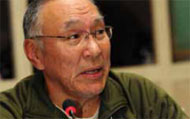
“I never thought of the angle of ‘our’ when I think of animals. Talk of pets, talk of food in the grocery store, but not of our animals linked to the land. So from now on in my mind, ‘our land’ will go hand in hand with ‘our land and our animals’.”
Lyne Mercier, National Energy Board Member
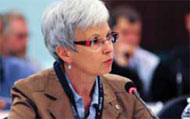
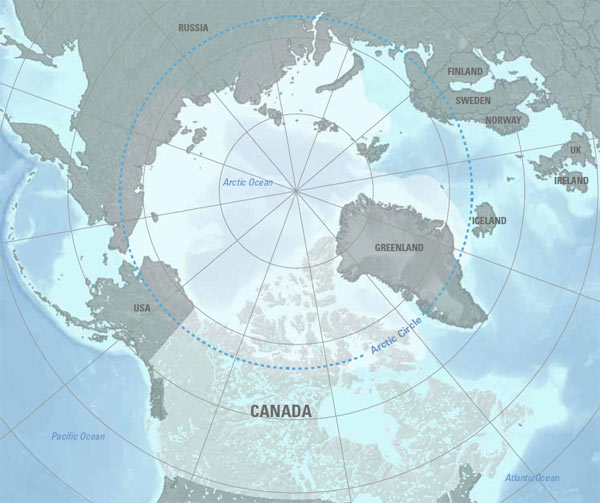
Frank Pokiak, from Tuktoyaktuk, Northwest Territories, is the Chair of the Inuvialuit Game Council. He pointed out that communities in the Inuvialuit Settlement Region depend on marine, rather than land-based, animals for their food. He stressed the importance of the ocean to the Inuvialuit people by saying: “... if it wasn’t for the Beaufort Sea I don’t think the Inuvialuit would exist today”.
Duane Smith, from Inuvik, Northwest Territories, referred to many of the concerns that were raised as issues of “food security”.
Mr. Smith also spoke about the Inuit circumpolar perspective, which includes Inuit from the United States, Canada, Greenland, and Russia.
Mr. Smith, who also serves as Vice-Chair of the Inuvialuit Regional Corporation and President of the Inuvik Community Corporation, said that any offshore activity in the Canadian Arctic could affect the entire circumpolar Arctic region. Negative effects on marine species in Canada would affect people in other regions who depend on those same resources. Animals and fish don’t recognize international boundaries.
“The Inuit community is local, it’s also global. As I’ve shown you on the map from Greenland to Russia, we’re one Arctic, one ocean, and we’re all connected.”
Duane Smith,
President, Inuit Circumpolar Council (Canada), Inuvik, Northwest Territories
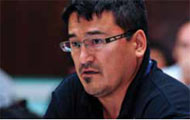
Some participants were worried that if there was a spill or an accident in the Arctic offshore, the environment and the animals would not be able to recover. They told us that the shoreline is sensitive and ecologically important as a habitat for migratory waterfowl, which many coastal communities rely on. They said that an oil spill could be devastating to their traditional way of life.
Participants talked about the harsh conditions in the Arctic Ocean, including how strong currents and changing ice conditions could impact drilling. Not only is the region very cold, with extreme temperatures and periods of 24 hours of darkness, but the Arctic Ocean is also prone to very high winds and is covered in ice for much of the year. Others spoke of their traditional knowledge, which says that many species, such as whales, polar bears, and sea birds, rely heavily on the leads, or open stretches of water, in the sea ice.
We heard that offshore drilling in the Canadian Arctic might be acceptable to some. However, they told us that if there is to be drilling in the unique Arctic environment, it must be done right. The environment, the people, and the animals that live in Canada’s North must be protected.
We heard that it is important for us to understand the relationship between oil and gas development and maintaining values and a quality of life.
Transcripts of the Arctic Review Roundtable are posted on our website.
“In regards to offshore drilling ... I’m not here to say we shouldn’t have offshore drilling but these animals and the land will not speak for themselves, we are their voices.”
Andrew Iqalukjuak, Clyde River, Nunavut

“My Dad, Bertram Pokiak said: to protect the land don’t accept money too fast. We will never lose our land code. Our land is our bank. What you have, save now, don’t spend too fast. Our oceans have a mind of their own. The animals are saying watch over us.”
Elizabeth Pertschy, Edmonton, Alberta 13
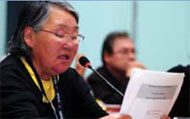
Chapter 3: What does the National Energy Board regulate in the Canadian Arctic?
The National Energy Board is the federal body responsible for regulating offshore drilling activities in the Canadian Arctic. Our responsibilities stretch for the entire life of the well, from the application stage, through exploration and production activities, and even after the well is eventually abandoned.
Our role includes a number of specific responsibilities such as overseeing:
- geophysical surveys (for example, seismic surveys);
- exploration wells to see if oil or gas is present;
- delineation wells to confirm the size of a potential oil or gas field;
- development wells for producing oil and gas;
- building and operating production facilities and facilities for transporting oil and gas; and
- abandoning wells and facilities.
Abandoning a well or related facilities means that the operator must prepare the well so that it can be left indefinitely. The operator must make sure that the well will not leak and damage water supplies or other potential oil and gas reservoirs. The operator is still responsible for the well even after it has been abandoned.
We do not regulate offshore activities off the coasts of either Nova Scotia or Newfoundland and Labrador. The Canada-Nova Scotia Offshore Petroleum Board and the Canada-Newfoundland and Labrador Offshore Petroleum Board, respectively, regulate these areas.
How are oil and gas resources managed in the North?
While any company wishing to drill in the Canadian Arctic offshore must apply to the National Energy Board for a drilling authorization, the first step is to obtain an Exploration Licence. An Exploration Licence gives a company the right to explore for, and the exclusive right to drill and test for, oil and gas. This licence, issued by the Minister of Aboriginal Affairs and Northern Development, is granted for up to nine years.
The process for getting oil and gas rights to land owned by the Government of Canada, including land under the ocean, is called the rights issuance process. The Department of Aboriginal Affairs and Northern Development manages this process, which is similar to an auction. This process falls under the Canada Petroleum Resources Act. This means that the financial side of Arctic offshore oil and gas development is clearly separated from the safety, environmental, conservation, and technical issues. One federal department looks after the financial side and we focus solely on the rest. There is a clear separation between issuing oil and gas rights and issuing a regulatory authorization to drill.
More information on the rights issuance process is available on the Department of Aboriginal Affairs and Northern Development website under “Northern Oil and Gas”.
“... if we are satisfied that the well should proceed we may authorize it and we may authorize any conditions that we find are necessary to promote safety and the protection of the environment and protection of the community. We also have the legal authority to say no, to deny the application because it doesn’t meet our requirements ... So as they say, the buck stops here ... ”
Gaétan Caron,
National Energy Board Chair
“Possible good outcomes of offshore drilling and exploration that I believe can happen; educational opportunities are a good thing. The offshore oil and gas activity could give more employment opportunities for young trades-people and professionals to get better in their skills. It could also give an idea of what we would like to go into for college or university and will also mean that we would have a place to come back to with a possible job opportunity.”
Allison Baetz, Grade 12 student, Samuel Hearne Secondary School, Inuvik, Northwest Territories

| Activity | Responsible Organization |
|---|---|
| Issuing Exploration Licences | Department of Aboriginal Affairs and Northern Development |
| Issuing Authorizations and Approvals for wells | National Energy Board |
| Issuing Significant Discovery Declarations | National Energy Board |
| Issuing Commercial Discovery Declarations | National Energy Board |
| Issuing Significant Discovery Licences | Department of Aboriginal Affairs and Northern Development |
| Issuing Production Licences | Department of Aboriginal Affairs and Northern Development |
| Managing royalties from oil and gas production | Department of Aboriginal Affairs and Northern Development |
The Minister of Aboriginal Affairs and Northern Development is also responsible for reviewing benefits plans for a proposed project. A benefits plan is a plan for the employment of Canadians and for providing Canadian companies with a fair opportunity to participate in the supply of goods and services.
The company is expected to develop these plans in consultation with the affected communities and land claim organizations where the proposed oil and gas activity may take place. A company is also required to submit an annual report to the Department of Aboriginal Affairs and Northern Development which describes the employment, training, and business benefits that occurred from the oil or gas activity.
The Minister must either approve, or waive the requirement for the approval of, a benefits plan before we can consider issuing an authorization.
Note to table the Department of Natural Resources issues Exploration Licences, Significant Discovery Licences, and Production Licences and manages royalties from oil and gas production for areas such as Hudson Bay, James Bay, and Hudson Strait.
During the Arctic Review Roundtable, we heard many comments about opportunities for training and education. We also heard that offshore drilling in the Canadian Arctic could provide potential jobs for local residents.
Benefits such as employment and training are included in a benefits plan. We do not examine these plans. The Minister may require that a benefits plan include provisions to ensure that disadvantaged individuals or groups have access to training and employment opportunities.
What is the National Energy Board’s role in reviewing applications for offshore drilling?
Once a company has acquired an Exploration Licence, they must apply to the National Energy Board for an Operating Licence, an Operations Authorization, and a Well Approval before before they can carry out any drilling-related activities. These requirements are laid out in the Canada Oil and Gas Operations Act. The purpose of this act, among other things, is to promote the:
- safety of the public and workers;
- protection of the environment; and
- conservation of oil and gas resources.
There are a number of mandatory regulations which fall under the Canada Oil and Gas Operations Act. The principal regulations relating to drilling are the Canada Oil and Gas Drilling and Production Regulations. These detail what an applicant must do to obtain an authorization for offshore oil and gas drilling or production activities. Operators are required, under the Canada Oil and Gas Drilling and Production Regulations, to take all reasonable precautions to ensure safety and environmental protection.
In the past, our regulations were prescriptive, specifying design and operational details. The challenge with this style of regulation is the “one-size-fits-all” approach. For example, the older Canada Oil and Gas Drilling Regulations specified well casing details such as minimum design factors for burst, collapse, and tension. In the current Canada Oil and Gas Drilling and Production Regulations, the operator needs to ensure that, among other things, the well and the casing are designed so that the well can be drilled safely and withstand anticipated conditions and forces that may be placed on it.
The new Canada Oil and Gas Drilling and Production Regulations came into effect in late 2009. These regulations define the safety and environmental protection outcomes to be achieved. Companies must persuade us that they have selected the appropriate means to achieve those outcomes. Where appropriate, the regulations also contain prescriptive elements including necessary management processes and reporting requirements. We will only authorize a project if we are satisfied that it may proceed safely while protecting the environment.
“The training that usually comes to the region or the communities is ... usually at the low end, so we always end up with the low end paying jobs. It would be nice to see if we could get some real training into the communities at the community level, where it will be successful. And it would be nice if we could get some training where it’s going to help us get work after the job is done within the region ... it would be nice if industry could work together to bring training towards ... a community level.”
Joshua Oliktoak, Director, Ulukhaktok Community Corporation and Olokhatomiut Hunters and Trappers Committee, Ulukhaktok, Northwest Territories
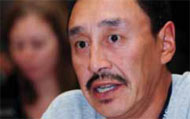
One of the expert reports that we commissioned for the Arctic Review compared offshore drilling regulatory regimes in Canada with those in Greenland, Norway, the United Kingdom, and the United States. The report focused on management systems, drilling, well control, independent verification, and oil spill response requirements. Canada’s framework is similar to Norway’s, which is recognized as the leader in these areas. This report was prepared by the Pembina Institute and is available on our website.
Before we can approve an application for offshore drilling activities, we must make sure that an environmental assessment is completed. The timing for an environmental assessment typically starts well in advance of a drilling application being submitted or early in the application process. The environmental assessment is based on a project description provided by the company, combined with the additional information we may require when we review the project.
The project description includes information about potential impacts on the environment, including potential impacts from accidents and malfunctions, socio-economic impacts caused by environmental effects, and mitigation measures to protect the environment. We also require information about the public consultation that the applicant conducted for the project. The proposed location of a project determines which environmental assessment process is used when conducting the assessment.
The Canadian Environmental Assessment Act applies to offshore drilling projects in the Beaufort Sea, which are within the Inuvialuit Settlement Region. This act also applies to projects outside of the Nunavut Land Claims Agreement area (beyond the Land Fast Ice Zone). We keep the Nunavut Impact Review Board updated and we seek their comments during the process.
Projects that are proposed for the Inuvialuit Settlement Region also require an environmental screening or review under the Inuvialuit Final Agreement. The Environmental Impact Screening Committee conducts the environmental screening. If necessary, the Environmental Impact Screening Committee may refer a project to the Environmental Impact Review Board for an environmental impact assessment and public review. When the Environmental Impact Screening Committee or Environmental Impact Review Board carry out an environmental assessment, there is often a public consultation period that identifies local issues and perspectives. We must see the decision and recommendations from the Environmental Impact Review Board before we make our regulatory decision.
The Nunavut Impact Review Board screens proposed projects in the Nunavut Land Claims Agreement area to determine whether a review is required.
“The NEB should continue to regulate offshore drilling in the Arctic using this goalbased approach which demands that operators take full accountability and responsibility for all aspects of the drilling operation while identifying and employing the best proven technologies to ensure safe and environmentally responsible operations.”
Mike Peacock, Imperial Oil
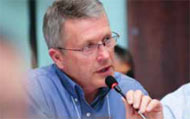
“I guess my strongest recommendation is that we have the one opportunity to make this right, to apply the highest and most stringent standards for any resource exploration so that we can conduct that activity and demonstrate to the world that we can do it.”
Duane Smith, President, Inuit Circumpolar Council (Canada), Inuvik, Northwest Territories
How do we conduct a technical review of an application for offshore drilling in Canada’s Arctic?
Before we grant any authorization to drill a well in the Canadian Arctic offshore, we will conduct a thorough technical review of the application. This technical review looks at a range of issues such as safety, environmental protection, how the applicant will respond if something goes wrong, and how they will pay for any accidents.
This technical review will be conducted by our expert staff and overseen by Board Members. The NEB has approximately 85 people focused on drilling, safety, engineering, environment, geoscience, socio-economics, and lands. These specialists have the experience, skill, and know-how to see that the facilities we regulate are safe, secure, and operated in a way that protects the environment.
We also have a history of working with other regulators in Canada and around the world. We continually take advantage of opportunities to learn from each other. We are active participants in the International Regulators Forum, the body dedicated to promoting best safety performance in offshore drilling.
In addition to a project description, which is submitted to us so we can complete an environmental assessment, an applicant must provide us with a Contingency Plan, a Safety Plan, and an Environmental Protection Plan.
Contingency Plan
The Contingency Plan sets out the procedures to identify the hazards and mitigate the associated risks of unplanned events, such as accidents and malfunctions, that might compromise safety or environmental protection.
Safety Plan
The Safety Plan sets out the procedures, practices, resources, sequence of key safety-related activities, and monitoring measures necessary to ensure safety.
Environmental Protection Plan
The Environmental Protection Plan sets out the procedures, practices, resources, and monitoring necessary to manage hazards and protect the environment from the proposed work or activity. Both the Safety Plan and the Environmental Protection Plan must include a summary of the measures to avoid, prevent, reduce, and manage the risks. The applicant’s Environmental Protection Plan should reflect the mitigation measures that have been committed to in the environmental assessment.
Other elements which must be addressed in an application for offshore drilling in the Canadian Arctic include management systems, proof of financial responsibility, same season relief well capability, Certificate of Fitness, and operational reporting and notification.
Management systems
The Canada Oil and Gas Drilling and Production Regulations say that an applicant must develop and implement a management system that includes processes to identify, evaluate, and manage risks to public and worker safety. An applicant’s management system must contain, among other things, processes for:
- ensuring that personnel are trained to perform their duties competently and safely;
- coordinating the management and operations of the proposed activity between the owner of the installation, the contractors, the operator, and any others who may be involved;
- internal reporting of hazards, injuries, incidents, and near-misses; and
- conducting periodic reviews and audits of their systems.
We evaluate the adequacy, implementation, and effectiveness of a management system through audits, inspections, and discussions with the operator. Continual improvement is a key requirement in a management system. During operations, our staff verify that the necessary improvements are being documented and implemented by the operator.
Proof of financial responsibility
Before receiving any authorization to drill offshore in the Canadian Arctic, a company must provide proof of financial responsibility in an amount and form satisfactory to the National Energy Board. We may suspend or revoke the authorization if the operator fails to maintain proof of financial responsibility for the duration of the work covered by the authorization.
Furthermore, we have full discretion over the forms and amounts of financial responsibility the company must put in place. There is no upper limit on the amount that we may require. Further discussion on financial responsibility and liability can be found in Chapter 6.
Same season relief well capability
The Canada Oil and Gas Drilling and Production Regulations say that an application for an authorization to drill an offshore well in the Canadian Arctic must include "... contingency plans, including emergency response procedures, to mitigate the effects of any reasonably foreseeable event that might compromise safety or environmental protection ...".
A relief well is one contingency measure used to respond to an out-of-control well. In the Canadian Arctic offshore, we have a policy that says the applicant must demonstrate, in its Contingency Plan, the capability to drill a relief well to kill an out-of-control well during the same drilling season. This is referred to as same season relief well capability.
The applicant must develop Contingency Plans that we find appropriate for the proposed project. These plans must take into account anticipated hazards and risks, and identify the appropriate equipment, procedures, and personnel for responding to anything that may go wrong.
The NEB’s Same Season Relief Well Policy is discussed in detail in Chapter 5.
Certificate of Fitness
An offshore drilling rig or drillship must have a valid Certificate of Fitness issued by an independent expert called a “certifying authority” before it can be used for any offshore drilling activity. The Canada Oil and Gas Operations Act and the Canada Oil and Gas Certificate of Fitness Regulations set out the factors that the certifying authority must consider, and define the organizations that are qualified certifying authorities. The scope of the work to be conducted by the certifying authority must be approved by our Chief Safety Officer before the applicant can obtain a Certificate of Fitness.
The requirement for a Certificate of Fitness provides us with independent verification that the drilling rig and drillship are fit for their intended purpose, work as they are intended to, and comply with the regulations without compromising safety or environmental protection. We verify that the applicant has ensured that the Certificate of Fitness for each drilling rig and drillship is valid throughout the authorized activity they are conducting.
Operational reporting and notifications
Operators are required to regularly report certain types of information. Daily reports are required while drilling, and incidents and near-misses have to be reported as soon as circumstances permit. This means that an operator must notify us of events such as significant injury, an imminent threat to safety, loss of containment from a well, pollution to the environment, or events that could have caused these incidents.
We can request additional information from an operator in relation to its authorized activities at any time.
Chapter 4: What have we learned?
As part of the scope of the Arctic Review, we committed to examining lessons learned from accidents, incidents, and emergency response exercises. Throughout the Review, we asked participants to tell us what they have learned from their previous experiences with offshore drilling.
We recognize that offshore drilling comes with risks. However, as was noted in the report to the President of the United States by the National Commission on the BP Deepwater Horizon Oil Spill and Offshore Drilling, “... even the most inherently risky industry can be made much safer, given the right incentives and disciplined systems, sustained by committed leadership and effective training.”
We commissioned Det Norske Veritas to write a comparative analysis of major incidents in order to identify trends related to root causes and contributing factors. This report, called Major Hazard Incidents, is available on our website. Claudine Campbell, our technical leader of safety, discussed the findings from this report at the Roundtable in Inuvik. She said:
The report authors also acknowledged how crucial it is for an operator to capture their contractors’ activities and learnings within their safety management system. In addition, it was noted that previous accidents and near-misses contained vital information about both active and latent threats to safety.
In the rest of this chapter, we take a closer look at what we have learned from previous offshore incidents. The list is by no means exhaustive, nor does it take into account what we have learned from near-misses. We also examine some of the lessons we have learned from other regulators, and discuss how a strong safety culture and a commitment to management systems contribute to offshore drilling projects that are safe and do not damage the environment.
What have we learned from the Ocean Ranger?
It began with a winter storm and a broken window.
It was a porthole window in the ballast control room of the Ocean Ranger. And shortly after 3 a.m. on 15 February 1982, this broken window led to the sinking of the largest self-propelled semi-submersible offshore drilling rig of its time and the l-oss of its 84 crew.
The broken porthole window and the ballast control room were located within range of the large waves splashing up from the Atlantic Ocean. A Royal Commission into the incident later determined that the glass in the window was not strong enough. There was a deadlight (steel cover) intended to cover the window. However, someone was required to check draft marks on the rig’s outer legs, which meant opening the deadlight. “This led to the habit of leaving the deadlight open at all times.”
On the afternoon of 14 February 1982, the Ocean Ranger’s crew started to disconnect from the wellhead off the coast of Newfoundland because a major storm was coming. That evening, the porthole window broke and seawater sprayed into the ballast control room.
Radio conversations from the Ocean Ranger overheard by other vessels in the area reported that “the control panel was wet and discharging shocks”, the valves used to control the stability of the rig were opening and closing on their own, and they needed an electrical technician.
“It’s going to be also dependent a little bit on the specific project that you’ve got, but there’s a lot of initiatives, a lot of lessons learned ... lessons learned coming from Macondo, and we’re going to apply all of those.”
Mike Peacock, Imperial Oil
“As the NEB considers the knowledge that has been shared from all the participants, you have my assurance that I will continue to respect the past, learn in the present, while considering our responsibility for the future of offshore drilling in the Canadian Arctic.”
David Hamilton, National Energy Board Member
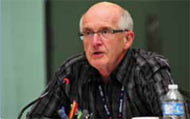
The ballast valves could be controlled manually by inserting or removing control rods. The crew appeared to believe that inserting the control rods would close the ballast valves. Instead, the crew was actually opening the valves to the ballast tanks, making their situation worse.
In 1982, “ballast operators were not formally trained nor did they have to pass tests to determine whether they understood the systems and their operation”.
In their report, Det Norske Veritas noted that the rig owner’s “career management policy focused on growth through experience without formal training ... This industry approach was not supported by sufficient training measures which showed a lack of commitment to formally improve employees and overall company performance in the area of safety”.
Just before 1:30 a.m. on 15 February, the Ocean Ranger issued a Mayday and the crew headed to lifeboat stations.
There is evidence that only one lifeboat was launched. It was damaged by the winter storm and capsized with at least 30 men on-board. The stand-by vessel took an hour to get to the scene and did not have the equipment to rescue the men who were in the water. Some of the crew died “while trying to climb onto the supply boat during a rescue attempt using improvised life ring lines”.
The Royal Commission found that there was inadequate lifesaving equipment on the rig. While there were four lifeboats, not all of them were installed. The Det Norske Veritas report also noted “emergency training was not mandatory and did not ensure evacuation procedures were well understood by the crew”.
What have we learned from the Piper Alpha?
It took less than 30 minutes. When it was over, three explosions and the resulting fire would make the Piper Alpha a tragic memory.
The Piper Alpha was located 193 kilometres northeast of Aberdeen, Scotland in the North Sea. The platform piped natural gas to shore and was linked via gas pipelines to two other offshore platforms in the area, the Claymore and the Tartan.
On the morning of 6 July 1988, the crew was carrying out routine maintenance to Condensate Pump A. As part of the maintenance, the pump’s pressure safety valve “was removed to be recertified”. In the meantime, the condensate line was temporarily sealed with a blind flange, “which was not fully tightened”. Because the work could not be completed by the end of their shift, the crew filled out paperwork stating that Pump A was not ready for service and must not be switched on.
Later that evening Condensate Pump B failed. Staff couldn’t find any paperwork about the status of Pump A and “assumed it would be safe to restart Pump A”. Pump A was re-started and highly pressurized gas condensate began to leak through “the less than leak-tight blind flange”.
The Det Norske Veritas report said “the crew did not follow procedures when they completed the fitting of the blind flange. The flange was not properly adjusted ...
From the filing requirements
4.5 Management systems
- Demonstrate that the management system has systematic, explicit, comprehensive, proactive, and documented processes for:
- the development of annual objectives and targets related to safety, security, environmental protection, conservation of resources, and a means to measure these objectives and targets;
- the establishment of competency requirements and effective training programs so that employees, operators, contractors, subcontractors, consultants, agents, and any other persons working with or on behalf of the applicant are trained, competent, and appropriately supervised to perform their duties;
In addition, the work situation and the status of the job was poorly communicated at the shift handover”.
Minutes after Pump A was switched on, a “gas cloud found an ignition point and the first explosion occurred”. A projectile ruptured a condensate line, starting a fire. The blast also destroyed the control room and, with it, the communications system, meaning there was no way to provide evacuation instructions to the Piper Alpha’s crew.
With a fire raging, approximately 100 men gathered in the fireproof accommodation block and waited for instructions. Those who tried to get to the lifeboat stations, which were all in the same location, found their path blocked by smoke and flames. The fire also prevented any rescue helicopters from landing. The Det Norske Veritas report cites a lack of emergency preparedness, including “no proper planning of alternative evacuation routes”, as one of the issues which contributed to the disaster.
Shortly after the first explosion, the fire ruptured the gas pipeline riser connecting the Tartan platform to the Piper Alpha. The Tartan was still pumping gas to the Piper Alpha, in effect, fuelling the fire. An inquiry later found that the “Tartan continued pumping because managers either had no authority or had not received communication” to shut in production.
Minutes later there was a third explosion, this time from the Claymore gas pipeline riser. The intense heat was destroying the Piper Alpha, including the fireproof accommodation block where many of the crew were located. Finally, the platform, including the accommodation block, “slipped into the sea”.
The accident took the lives of 165 of 226 men on-board, plus two rescuers, making it the world’s worst offshore oil and gas disaster.
What have we learned from the crash of Cougar Helicopter Flight 491?
The morning of 12 March 2009 started off well in St. John’s, Newfoundland and Labrador. The sun was bright, the sky was clear, and it was shaping up to be a good day for flying.
Shortly before 9 a.m., 17 men and one woman climbed aboard a Sikorsky S-92A, operated by local Cougar Helicopters, and headed to work. The plan was to stop first at the Hibernia platform, 315 kilometres from St. John’s, and then the SeaRose Floating Production Storage and Offloading vessel, located 350 kilometres from St. John’s.
Helicopter travel is a routine part of life in the offshore industry. However, it is not without risk.
The helicopter was 28 minutes into its 90-minute flight when a warning light flashed on. The two pilots issued a Mayday and headed for home. What they did not know was that two of three titanium studs connecting the oil filter to the helicopter’s main gearbox had broken off mid-flight and the aircraft was rapidly losing oil pressure. The gearbox is part of the system that turns the main and tail rotors and is essential to the helicopter’s operation.
From the Filing Requirements
4.5 Management systems
- Demonstrate that the management system has systematic, explicit, comprehensive, proactive, and documented processes for:
- the evaluation and management of risks associated with all hazards, including the risks related to normal and abnormal operating conditions, and the development, implementation, and communication of preventative, protective, and mitigative measures for identified hazards and risks;
- internal and external communications that support safety, security, environmental protection, conservation of resources, and the effective implementation and operation of the applicant’s management system;
From the Filing Requirements
5.6 Marine capability of the drilling system
- Describe the drilling unit and support craft that will be used to drill in the extreme physical conditions anticipated in the unique Arctic environment, including:
- systems for escape, evacuation, and rescue of personnel involved in drilling and support operations in all operating conditions including personnel in transit to the drilling installation in the Arctic offshore.
Just 11 minutes later, Cougar Flight 491 slammed into the North Atlantic, 55 kilometres southeast of St. John’s, taking all 18 on-board with it. Only Robert Decker survived the crash. Mr. Decker was in the water amidst the wreckage for more than an hour before he was plucked from the sea by Cougar’s own rescue aircraft.
Following the crash, the Honourable Robert Wells led a Commission of Inquiry. The purpose was to examine offshore helicopter safety. His mandate did not extend to examining what caused the Cougar crash, which is the role of the Transportation Safety Board. Commissioner Wells’ final report contained 29 recommendations, including a call for the creation of a new regulatory body which should be “independent from all other components of offshore regulation and should stand alone, with safety being its only regulatory task”. He went on to say:
I believe the major safety development of the past 20 years has been the realization that safety regulation should be separate from the production aspects of the oil industry in order to avoid the conflicts which could arise when both activities are presided over by a single regulator.
The report also pointed out that in the unique offshore environment, first response capability is critical.
At the time of the crash, the offshore oil companies operating in Newfoundland and Labrador had a contract with Cougar Helicopters to provide first response services. This contract called for the aircraft to be “wheels-up” in under an hour. As Cougar did not have a helicopter dedicated to emergency response, it took the company 50 minutes to remove the passenger seats from the stand-by helicopter, install the necessary search and rescue equipment, and take off. In his report, Commissioner Wells recommended that operators should be required to have a dedicated aircraft with a 15-20 minute wheels-up response available at all times.
Throughout his report, Commissioner Wells was clear that changes are necessary, particularly the need to “improve and maximize worker participation in developing and advancing safety”. Workers have a significant responsibility for ensuring their own safety, he said. There needs to be wider worker, public, and stakeholder engagement. This includes the sharing of regulatory assessments with the public.
Commissioner Wells’ report can be found on our website.
What have we learned from the Montara blowout?
It was called a failure of sensible oilfield practices.
More specifically, an inquiry commissioned by the Australian government found that “the way that PTTEPAA [PTT Exploration and Production Australasia] operated the Montara Oilfield did not come within a ‘bulls roar’ of sensible oilfield practice”. The blowout at the Montara H1 Well was the worst of its kind in the Australian offshore petroleum industry’s history.
From the Filing Requirements
4.13 Transportation and helicopter safety
Describe the applicant’s helicopter transportation safety plan with enough detail to demonstrate that:
- the plan effectively manages the hazards and risks associated with helicopter transportation in the unique Arctic environment;
- all safety equipment, including personal protective equipment (PPE), is suitable and adequate for the hazards and risks associated with helicopter transportation; and
- adequate planning and assistance are in place for aircraft in distress and airborne emergencies.
4.7 Safety culture
- Describe how workers will be actively engaged in the process of safety management throughout the life cycle of the project.
On 21 August 2009, contractors for PTT Exploration and Production Australasia were drilling in the Montara field. The field is located 250 kilometres northwest of Western Australia and included the Montara H1 Well.
At the time of the incident, the well had been temporarily suspended while the contractor was using a jack-up drilling rig called the West Atlas to work on another nearby well. The well had the following well barriers in place before the well was initially suspended:
- a cemented 9 5/8” (244 mm) casing shoe;
- a cemented 9 5/8” (244 mm) casing annulus;
- inhibited seawater; and
- a 9 5/8” (244 mm) pressure containing corrosion cap.
At this point, there was no wellhead or blowout preventer installed on the well.
The Montara Commission Inquiry later “found that at the time the H1 Well was suspended in March 2009, not one well barrier complied with the operator’s own Well Construction Standards ... Relevantly, the 9 5/8” (244 mm) cemented casing shoe had not been pressure-tested in accordance with the company’s Well Construction Standards, despite major problems having been experienced with the cementing job”. Then, on the morning of 21 August 2009, Montara H1 Well experienced a “kick”.
In the drilling industry, a kick is an indication that unintended formation fluids have entered the wellbore. When fluids with a higher pressure than the pressure exerted by the drilling mud enter the wellbore, the well may need to be shut in quickly or a kick can escalate to a full-scale blowout.
The West Atlas rig was headed back to the Montara H1 Well to install additional well barriers when the well suffered a second kick. This time a stream of oil and gas shot to the surface and control of the well was lost that same day.
While all 69 workers made it to safety, an estimated 29,600 barrels (approximately 4,700 cubic metres) of oil was released into the Timor Sea over 74 days until a relief well was completed in early November and brought the well under control.
Among the findings and recommendations included in their report, the Commission of Inquiry identified two broad categories of likely causes for the incident.
The direct cause of the blowout was the failure of the primary well barrier, the 9 5/8” (244 mm) cemented casing shoe. The casing shoe was intended to act as a primary line of defense against a potential blowout.
The report also identified systemic failures in how the operator implemented the regulatory regime, rather than inadequacy of the regulations themselves.
The Montara Commission of Inquiry report is posted on our website.
From the Filing Requirements
5.9 Cementing program
Describe the applicant’s cementing program with enough detail to demonstrate that the cementing will:
- isolate oil, gas, and water zones;
- provide support for the casing, including the prevention of corrosion of the casing, over the cemented interval; and
- support the integrity of the wellbore and the reservoir.
5.11 Well barriers
Describe the well integrity and well barriers with enough detail to demonstrate that:
- at least two independent and tested physical well barriers are in place during all well operations;
- reliable well control equipment is installed to control kicks, prevent blowouts, and safely carry out all well activities and operations, including drilling, completion, and work-over operations; and
- if well control is lost, or if safety, environmental protection, or resource conservation are threatened, the operator will take any action necessary to rectify the situation without delay, despite any condition to the contrary in the Well Approval.
What have we learned from the Deepwater Horizon?
Following the Deepwater Horizon incident in the Gulf of Mexico, several countries, including Canada, announced their intention to examine the accident and learn from it. United States President Barack Obama announced the creation of the National Commission on the BP Deepwater Horizon Oil Spill and Offshore Drilling on 22 May 2010.
In their Report to the President, the Commission found that the Deepwater Horizon incident could have been prevented and that the “immediate causes of the Macondo well blowout can be traced to a series of identifiable mistakes ...”.
The Commission went on to note “there are recurring themes of missed warning signals, failure to share information, and a general lack of appreciation for the risks involved. In the view of the Commission, these findings highlight the importance of organizational culture and a consistent commitment to safety by industry, from the highest management levels on down”.
In their report, the Commission documented the weaknesses and the inadequacies of the federal regulation and oversight, and made important recommendations for changes in legal authority, regulations, investments in expertise, and management. Recommendations to government follow eight themes:
- Improving the Safety of Offshore Operations;
- Safeguarding the Environment;
- Strengthening Oil Spill Response, Planning, and Capacity;
- Advancing Well-Containment Capabilities;
- Overcoming the Impacts of the Deepwater Horizon Spill and Restoring the Gulf:
- Ensuring Financial Responsibility;
- Promoting Congressional Engagement to Ensure Responsible Offshore Drilling; and
- Moving to Frontier Regions.
From the Filing Requirements
4.11 Safety Plan
Include a Safety Plan in all applications for an authorization. The Safety Plan should provide enough detail to demonstrate that it sets out the procedures, practices, resources, sequence of key safety-related activities, and monitoring measures necessary to ensure the safety of the proposed work or activity.
The recommendations focus on the roles of industry and government in improving the safety of offshore operations and protecting the environment. In their report, the Commission focused on regulatory regime models that are more risk-based and incorporate the safety case. According to the Report to the President, “the term ‘safety case’ is a shorthand expression for a comprehensive and structured set of safety documentation that provides a basis for determining whether a risk management system for a specific vessel or equipment is adequately safe for a given application in a given environment”. These recommendations lead to a regulatory regime consistent with the one we administer.
The Report to the President: National Commission on the BP Deepwater Horizon Oil Spill and Offshore Drilling is available on our website.
What have we learned from other regulators?
The Canada-Newfoundland and Labrador Offshore Petroleum Board regulates drilling off the coast of Newfoundland and Labrador, including the Hibernia, Terra Nova, White Rose, and North Amethyst fields. In his presentation to the Roundtable in Inuvik, the Chairman of that Board, Max Ruelokke, spoke about the Lona O-55 exploration well which Chevron drilled in about 8,000 feet (2.4 kilometres) of water at the same time that the Macondo well was spilling 5 million barrels of oil into the Gulf of Mexico. This led to significant public scrutiny of the Lona O-55 well.
The Canada-Newfoundland and Labrador Offshore Petroleum Board took additional measures to make sure the well would be drilled safely. These measures included:
- establishing an oversight team to coordinate oversight of the project and to make sure that the regulator received daily reports from the field;
- monitoring the lessons learned from the Deepwater Horizon incident and increasing the frequency of audits and inspections from once every three or four months to once every three or four weeks;
- calling an operations timeout before critical phases during the drilling program – the purpose was to make sure that everybody understood what was required to get safely through the next phase of the well and to make sure that it was done in a way that protected the environment;
- observing key operations from on-board the rig – the Canada- Newfoundland and Labrador Offshore Petroleum Board sent a senior drilling engineer to the rig during specific times in the drilling program to make sure that “things were being done as they should have been”;
- ensuring that spill response equipment was ready for rapid deployment in case things should go wrong; and
- reviewing the well termination program because it was during this activity that the Deepwater Horizon crew lost control of the Macondo well.
We consider many of these steps to be best practice in terms of regulating offshore drilling. In particular, the concept of calling an “operations timeout” or safety “stand down” at critical phases during the drilling program would give us the opportunity to make sure that everyone understands the next steps in the process and that the equipment and procedures in place are acceptable. We would only allow the drilling process to continue when we were convinced that drilling will be safe and will not harm the environment.
How do management systems contribute to a safety culture?
When we look at the root causes of these incidents, we find a common thread: a neglect of, or even an absence of, processes and procedures to identify, mitigate, or eliminate potential risks. Beneath that deficiency lies an even deeper and more disturbing pattern of organizational cultures that did not put safety first.
“... if you spend time, as I have, reading disaster inquiries they are depressingly similar. You just have to change a few technical details but the causes are always the same.”
Mark Fleming, Saint Mary’s University, Halifax, Nova Scotia

From the Filing Requirements
4.7 Safety culture
Describe the management system with enough detail to demonstrate organizational commitment and support for the development and maintenance of a positive safety culture.
What is safety culture?
An organization’s safety culture is made up of both individual employee and group beliefs, values, attitudes, and behaviours about safety. A positive safety culture is characterized by “... communications founded on mutual trust, by shared perceptions of the importance of safety and by confidence in the efficacy of preventative measures”.
In other words, a strong safety culture always puts safety, and the practices of continually making things safer, first.
We invited Dr. Mark Fleming of Saint Mary’s University to the Inuvik Roundtable so participants could learn more about the importance of safety culture in preventing things from going wrong in offshore drilling.
In his report, Safety Culture Review Implications for Regulators, Dr. Fleming cites four common cultural factors identified in inquiry reports from 17 major disasters, including the offshore disasters Piper Alpha, Ocean Ranger, and Deepwater Horizon. These are:
- tolerance of inadequate systems and resources – front-line employees are willing to tolerate poor systems, maintenance, or inadequate resources;
- deviation from safety policy becomes normal and accepted – employees accept that not everyone will follow the rules laid out in organizational policy, or that the rules do not necessarily need to be followed in order to operate safely;
- complacency – major disasters are rare, though catastrophic. Because they do not happen frequently, employees and management begin to feel that they simply will not happen, no matter how highhazard daily operations may be; and
- work pressure – the pressure to meet deadlines or cut costs can overwhelm the desire or directive to follow procedures, take precautions, or even stop work if something does not appear to be right.
“There is often an observable disconnect between the company’s visions and policies, or what they say, and their planning, implementation, monitoring, and review, what they, in fact, do.”
Claudine Campbell, National Energy Board
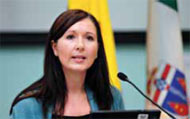
“When I read disasters, really what becomes clear to me is that they are, you know, failures that occur due to people not doing what they are supposed to do. These are not random failures of individuals that have occurred, but systematic processes that break down the social fibre within the organization.”
Mark Fleming, Saint Mary’s University, Halifax, Nova Scotia
These findings point to deficiencies in organizational safety culture: deficiencies that lead to the worst possible outcomes. Dr. Fleming’s work asks the question, “given the demonstrated link between an organization’s safety culture and their ability to drill safely, what can the regulator do to make certain that an operator has a strong safety culture?”. Dr. Fleming recommends that regulators hold industry accountable for growing a healthy safety culture and audit companies to observe and validate that safety culture. We agree.
Applicants must demonstrate to us that they have a strong safety culture. It is the primary foundation of all other requirements that address the health and safety of workers and the public, as well as the protection of the environment. This is especially significant for any proposed operations in the Arctic, where the transient nature of offshore drilling and the Arctic environment pose unique challenges to a sustainable safety culture.
How can a regulator drive development of a safety culture?
If the desired outcome is a safety culture where every individual, from the Chief Executive Officer to the rig worker, cares about and acts to promote safety, management systems are the tool through which this outcome is achieved. Unfortunately, in addition to safety culture, another common thread links the root causes of industrial disasters: the lack of robust safety management systems.
In each of the cases assessed in the Det Norske Veritas report that we commissioned, it was clearly demonstrated that, while the operating organization may have had safety policies and management commitment statements to them in place, hazard identification, risk assessment, and the necessary related controls were deficient.
In the context of an application to drill a well, a management system is a framework of plans, processes, and procedures used to ensure that an applicant can meet the regulatory requirements and objectives concerning health, safety, and the environment, identify hazards, and mitigate or eliminate risks. Companies must demonstrate to us their ongoing adherence to a management system. We must be satisfied that someone in the company is effectively and rigorously accountable for the maintenance and implementation of such a system. The applicant needs to persuade us that it has processes in place for conducting reviews or audits of the system and for taking corrective actions if reviews or audits identify areas of non-conformance or opportunities for improvement.
Management systems include processes for:
- hazard identification;
- risk management;
- personnel competence and training;
- emergency preparedness;
- internal reporting; and
- performance monitoring and compliance.
Management systems inherently focus on continual improvement using information captured from front-line workers, industry intelligence, incidents, and even “near-misses” to review and improve the existing system.
We currently require that all regulated companies and applicants demonstrate, to our satisfaction, comprehensive and well-executed management systems. Our regulatory framework provides clear and unambiguous direction for the implementation of management systems. As stated in Chapter 3, in Canada, management systems are required by the Canada Oil and Gas Drilling and Production Regulations for offshore drilling authorizations and approvals. We also require that the management system be maintained and updated during drilling operations.
We evaluate the implementation and effectiveness of management systems using a risk-based program that includes audits, inspections, and other compliance and enforcement tools.
From the Filing Requirements
4.5 Management systems
Describe the management system with enough detail to demonstrate:
- the integration of operations and technical systems with financial and human resource management for the purposes of achieving safety, security, environmental protection, and conservation of resources;
- how the system ensures compliance with the Canada Oil and Gas Operations Act and its regulations, and any authorizations and approvals issued by the Board;
- that it applies to plans, programs, manuals, and systems required under the Canada Oil and Gas Operations Act and its regulations;
- that it corresponds to the size, nature, and complexity of activities authorized under the Canada Oil and Gas Operations Act and its regulations, and the associated hazards and risks; and
- that it provides a strong foundation for a pervasive culture of safety, forcefully affirmed by the organization’s leadership, rigorously documented in writing, known to all employees involved in safety and environmental protection, and consistently implemented in the field and on the drilling platform.
Chapter 5: How can drilling be done safely while protecting the environment?
Throughout the Arctic Review, we heard that, if companies are going to be permitted to drill in the Canadian Arctic offshore, it must be done right. Our goal is to see that energy facilities are safe and are built and operated in a manner that protects the environment.
We have the primary responsibility under the Canada Oil and Gas Operations Act, which governs offshore drilling in the Canadian Arctic. The purpose of this act, among other things, is to promote safety and the protection of the environment. This act gives us the authority to attach requirements to the authorizations that we issue in order to achieve these goals. If these requirements or the applicable regulations are not met, the Board can suspend or revoke the authorization. Accordingly, any company planning to drill in the Canadian Arctic offshore must demonstrate to us that they can drill safely while protecting the environment. If the company can’t do this, they can’t drill.
We are a full life cycle regulator for oil and gas drilling and production. This means that we are responsible for regulating a project from start to finish, from the application, through the production phase, and even after a well is eventually abandoned. We make sure that an operator does what they promised they would do. We verify compliance with the legislation and conditions of authorizations and approvals by meeting with the company and conducting inspections and audits. We focus on safety, environmental, and technical issues. We do not decide whether an area will be open for bids nor do we regulate or collect royalties from oil and gas leases. These are the responsibilities of the Department of Aboriginal Affairs and Northern Development or, in some areas, the Department of Natural Resources.
There are a number of regulations under the Canada Oil and Gas Operations Act which explain the requirements for a company operating an offshore drilling project in the Canadian Arctic. The Canada Oil and Gas Drilling and Production Regulations say that, when a company applies for an authorization to drill in the Arctic offshore, they must provide us with:
- a Safety Plan, that sets out the procedures, practices, resources, sequence of key safety-related activities, and monitoring measures necessary to ensure the safety of the proposed work or activity;
- an Environmental Protection Plan, that describes the procedures, practices, resources, and monitoring necessary to manage hazards and protect the environment from the proposed work or activity; and
- Contingency Plans, including emergency response procedures, that describe how the effects of any reasonably foreseeable event that might compromise safety or environmental protection will be mitigated.
In addition to the regulations, we can impose conditions on a company’s authorization to drill in order to promote safety and environmental protection. Furthermore, the filing requirements noted in this report, and further detailed in the companion document to this report, Filing Requirements for Offshore Drilling in the Canadian Arctic, include our filing expectations for future applications for offshore drilling projects.
“I do recognize similarities between the National Energy Board and our own Petroleum Safety Authority (PSA). I worked in the industry for 28 years, and I remember the system change in the PSA as well. We had to stop asking what do the PSA want us to do, but rather, what do we want to do to ensure the best outcome. And that is how it should be, because at the end of the day, we are ultimately responsible.”
Dagfinn Alm, Statoil (Norway)
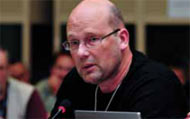
How will the National Energy Board be ready for applications to drill in the Canadian Arctic offshore?
Throughout the Arctic Review, we heard that, as the regulator of offshore drilling in the Canadian Arctic, we have a responsibility to be ready for future applications.
We have staff with the offshore expertise and experience necessary to assess, inspect, and conduct audits of offshore drilling projects. This includes geophysicists, geologists, drilling engineers, safety engineers, offshore structures engineers, safety inspectors, environmental specialists, and marine emergency response experts. We benefit from a significant expert resource in the certifying authorities who examine and certify every drilling rig and drillship. We have an agreement with the Canada-Nova Scotia Offshore Petroleum Board to share experienced personnel through a staff exchange, as needed.
In addition, we work with a major engineering firm to provide technical services when we run into very specialized technical issues where we may benefit from additional expertise. We will be ready to apply the highest scrutiny necessary to any future applications for offshore drilling in the Canadian Arctic. As the offshore drilling workload of the Board grows, we will add the necessary capacity.
How do we know that drilling equipment will be safe?
The Canada Oil and Gas Certificate of Fitness Regulations say that every production installation, accommodation installation, and diving installation at an offshore production or drilling site is required to have a valid Certificate of Fitness. The Certificate of Fitness is issued by an independent expert organization called a certifying authority. A list of recognized certifying authorities is provided in the Canada Oil and Gas Certificate of Fitness Regulations.
The certifying authority independently conducts the work that is necessary to determine that the drilling rig and drillship, and the associated equipment such as blowout preventers and well control equipment, have been designed, constructed, transported, installed, operated, and maintained in accordance with the regulations.
By issuing a Certificate of Fitness, the certifying authority states that it has verified that the installation can be operated safely, without polluting the environment, and that it is fit for the purpose for which it is intended, such as drilling in offshore Arctic waters. The operator must ensure that the Certificate remains in force for as long as the equipment or installation is used.
In addition, once a Certificate of Fitness has been issued, the operator cannot modify any of the drilling equipment without authorization. The equipment must be certified and used according to the design.
“You know, it’s unfortunate that certain things look at the bottom line ... governments or the NEB have their laws to follow, businessmen have their bottom line to follow but ... nowadays good business is environmentally friendly business and I think that’s something that both industry and government should know.”
Eugene Pascal, Councillor, Hamlet of Aklavik, Northwest Territories
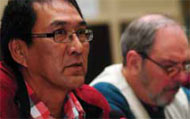
From the Filing Requirements
4.4 Certificate of Fitness
Describe the third party verification process with enough detail to demonstrate that a qualified independent third party has confirmed that the offshore installation, drilling system, and all safety critical systems are fit for purpose for the range of activities and location in which the activities will take place.
How will the National Energy Board make sure offshore drilling projects are safe?
We learned that accidents can happen not only because the regulatory regime was deficient, but because the operator did not effectively implement safety processes and systems required by the regulations. We hold operators accountable for meeting our regulations and the conditions of their authorization, and for honouring their commitments.
If we authorize an offshore drilling project, we will monitor the facilities and activities to verify that the operator is complying with our requirements throughout the life cycle of the project. Monitoring compliance is an essential tool that helps enable enforcement, promote continual improvement, and facilitate a deeper understanding of an operator’s systems and practices. We will respond to concerns and complaints that we receive on any matter under our mandate. If a concern does not fall under our mandate, we will inform the relevant authorities of the complaint.
We may use a variety of tools to verify compliance.
Audits are a systematic evaluation of an operator’s organization-wide management system, including programs, practices, procedures, plans, processes, manuals, records, systems, and activities. The objective is to verify that the operator is complying with regulatory obligations. Operators can be required to submit and implement corrective action plans, within specific time limits, to resolve any findings of non-compliance.
Inspections are an on-site methodical examination and assessment of an operator’s activities compared to their regulatory obligations and commitments. Our staff may conduct inspections at any time during the life cycle of the project.
Compliance meetings are used to:
- exchange information about an operator’s programs or our requirements;
- verify the operator’s implementation of their regulatory obligations and commitments; and
- assess the operator’s performance, provide feedback, and seek an operator’s commitment to improve as necessary.
Emergency response exercise evaluation are on-site evaluations of an operator’s capability to respond to an emergency in accordance with emergency response procedures and industry best practices.
Compliance verification tools and the prospect of regulatory enforcement have important roles to play in educating operators and encouraging future compliance. Our enforcement activities range from notifying the operator and providing opportunities for voluntary compliance, up to revoking and suspending their Authorizations or Operating Licences. Offences can also be prosecuted.
From the Filing Requirements
5.12 Blowout preventers and well control system
- Describe the process to ensure that no unauthorized modifications are made to any of the safety critical equipment.
We can use a variety of tools to compel compliance, including:
- a letter or notice, most commonly in the form of a Safety Advisory;
- an Assurance of Voluntary Compliance, which is a formal written undertaking given by an operator to correct a non-compliance;
- Board Orders to enforce regulatory obligations under the Canada Oil and Gas Operations Act, regulations, or authorizations;
- revoking an authorization that enables the company’s operation, if we lose confidence in their ability to operate safely or in a manner that protects the environment; and
- prosecution (through the Office of the Attorney General of Canada).
It is an offence to contravene provisions of the Canada Oil and Gas Operations Act and the Canada Labour Code, Part II. If we discover a serious offence, we will refer the details to the Office of the Attorney General of Canada for prosecution. Under the Canada Oil and Gas Operations Act, a person can be held liable to a fine of up to one million dollars if found guilty of an offence. In addition, offences under the Canada Oil and Gas Operations Act are continuing offences. This means that for each day that an offence continues, the offence is deemed a separate offence.
What tools are used to control a well?
Well control refers to techniques used to maintain pressure in the wellbore, to control or prevent flow of formation fluids into the wellbore. We require wells drilled in the Canadian Arctic offshore to have at least two independent and tested well barriers in place during all well operations to ensure well control and well integrity.
As the regulator, we examine an application for offshore drilling to see that there are built-in redundancies for well control systems and equipment, and the system is reliable. This is essential. Furthermore, the operator is required to immediately cease any activity that endangers, or is likely to endanger, the safety or integrity of the well.
Examples of well barriers are:
- drilling fluids;
- cemented casing and casing shoetrack;
- downhole packers and other plugs; and
- blowout preventers.
When drilling, the primary tool for controlling the well and avoiding a blowout is having sufficient weight of drilling fluid, known as “mud”, so that the pressure of the mud is enough to overcome the pressure from the underground formation surrounding the hole. A blowout preventer is a second line of defense and is essentially a large set of valves at the top of a well that may be activated if the primary well control fails. If the blowout preventer fails once control of the well is lost, the well could continue to flow at an uncontrolled rate, as was seen during the blowout in the Gulf of Mexico. This creates serious hazards to people, the environment, and property.
From the Filing Requirements
5.12 Blowout preventers and well control system
- Provide evidence that safety critical equipment, including shear rams installed in the BOP stack, are capable of shearing and sealing any pipe or wireline in the hole under maximum anticipated surface pressure.
- For the BOP stack, provide evidence that the BOP stack:
- is designed for the specific rig and appropriate for the specific well design;
- has not been compromised or damaged;
- will operate in the conditions in which it will be used; and
- has been maintained according to the original manufacturer’s specifications.
5.11 Well barriers
- Describe the well barrier policies, procedures, and work instructions that ensure that personnel are aware of the well barrier envelopes that are being relied on at any given point in time to prevent uncontrolled flow.
When wells are drilled in shallow water with an offshore rig that sits on the seafloor or on an artificial island, the blowout preventers are installed above the waterline. In offshore drilling operations which take place in deeper water with floating drilling rigs, such as a drillship, the blowout preventer is located underwater near the seabed. This is called a subsea blowout preventer.
Since blowout preventers are critical equipment for safe operations, we expect that they will be inspected, tested, and refurbished at regular intervals, according to industry best practices. The timing for these activities will be determined by a combination of risk assessment and the type of well being drilled.
We know from past incidents, such as the blowout and oil spill in the Gulf of Mexico, that while blowout preventers are an important tool in well control, they are not fail-safe. It’s important that we learn from these incidents.
According to the Canada Oil and Gas Drilling and Production Regulations, “the operator shall ensure that pressure control equipment associated with drilling, coil tubing, slick line, and wireline operations is pressure-tested on installation and as often as necessary to ensure its continued safe operation”.
As part of normal drilling operations, blowout preventers are expected to be regularly tested. Drilling crews will typically run certain tests before the start of a particular operation, such as running casing. In addition, the crew will typically run a pressure test approximately every week.
If the operator loses control of their well, they must have a Contingency Plan to regain well control. This plan could use various measures including:
- cap and containment methods;
- same-well intervention methods; and
- drilling a relief well.
“In its simplest terms a BOP stack (blowout preventer) is a series of valves. And before I describe the valves I want to make sure that everyone understands that a BOP is a secondary means of well control ... Your primary line of defence is always the mud that you have in the well or the hydrostatic fluid. So in the perfect scenario the BOPs are never utilized for a well control situation because you always maintain the mud weight that you need to keep the well under control.”
Kevin Carey, Chevron Canada Resources
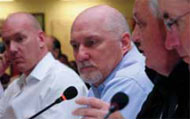
Blowout Preventer
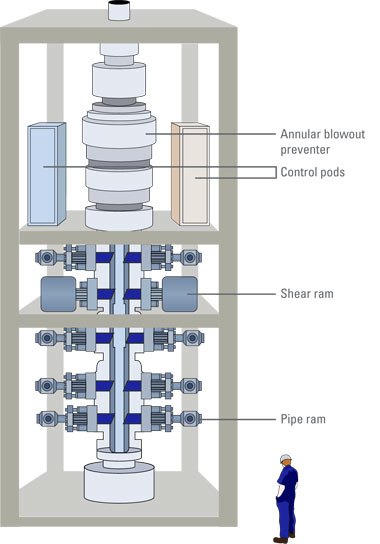
Learnings from the Macondo Well
What have we learned about blowout preventers?
- The blind shear rams must be capable of shearing the off-center drill pipe.
- All back-up control systems must have built-in redundancy.
- A robust change management process is required to manage changes and modifications to well control equipment.
From the Filing Requirements
4.17 Contingency plan for an uncontrolled release of reservoir fluids
- Same season relief well capability
Policy
In the Canadian Arctic offshore, we have a policy that says the applicant must demonstrate, in its Contingency Plan, the capability to drill a relief well to kill an out-of-control well during the same drilling season. This is the Same Season Relief Well Policy. The intended outcome of this policy is to minimize harmful impacts on the environment. An applicant must demonstrate this capability.
A relief well is one contingency measure employed to respond to loss of well control. An operator is also expected to continue well intervention using all available means to bring into control a well blowout while designing, mobilizing, and undertaking a relief well operation.
“Over time, what we’ve seen from recent experience at Macondo and continued efforts from industry, that certainly a relief well is not the only option in terms of killing a blowout and, in fact, it’s our ... belief that there are other more superior methods available to industry in terms of killing a blowout.”
Rod Maier, Chevron Canada Resources

What is the National Energy Board‘s policy regarding same season relief wells?
Under the Canada Oil and Gas Drilling and Production Regulations, we require the applicant to develop Contingency Plans appropriate for their project. These Contingency Plans must be submitted to us as part of their application. The regulations also say that the plans must take into account anticipated hazards and risks, and identify the appropriate equipment, procedures, and personnel for mitigating these hazards and risks.
A relief well is one contingency measure used to respond to an out-of-control well. In the Canadian Arctic offshore, we have a policy that says the applicant must demonstrate, in its Contingency Plan, the capability to drill a relief well to kill an out-of-control well during the same drilling season. This is referred to as same season relief well capability.
When Contingency Plans for a proposed project are submitted to us as part of an application, we thoroughly review and consider their adequacy. The plans can also be considered during any environmental assessment process for the proposed project.
During the Roundtable in Inuvik, we heard that, while relief wells are one option for killing a well that has gone out-of-control, there may be other methods which would achieve the same goal. As Mike Peacock from Imperial Oil told attendees, “... the Arctic environment requires all the tools in our toolbox to be available to the operators ...”.
We heard from other participants that, while they agree with the goal of regaining control of a well as soon as possible and not relying solely on a relief well, they had concerns about not including same season relief well capability as a tool in an operator’s toolbox.
The intended outcome of the Same Season Relief Well Policy is to kill an outof- control well in the same season in order to minimize harmful impacts on the environment. We will continue to require that any company applying for an offshore drilling authorization provides us with specific details as to how they will meet this policy. An applicant wishing to depart from our policy would have to demonstrate how they would meet or exceed the intended outcome of our policy. It would be up to us to determine, on a case-by-case basis, which tools are appropriate for meeting or exceeding the intended outcome of the Same Season Relief Well Policy.
In addition, we will continue to require an operator to use all intervention techniques available, in addition to a relief well, so that the flow from an out-ofcontrol well can be stopped as quickly as possible.
We acknowledge that there is a continual evolution of technology worldwide, including the technology needed to kill an out-of-control well. We are open to changing and evolving technology.
“An equivalent to SSRW capability would, in our view, be an Arcticproven alternative method to both control and kill a blowout before the end of the operating season. It would provide an alternative to samewell intervention methods where these are either not available or not applicable ... Finally, of course, it has to be capable of killing the well once it is under control. Anything less, we believe, could expose the Beaufort Sea to a blowout that could last through the winter.”
Rob Powell, Director, Mackenzie River Basin, WWF, St. Albert, Alberta
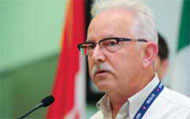
Offshore Relief Well
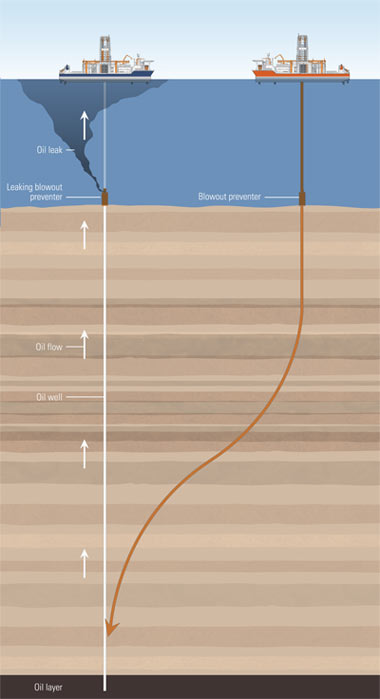
“Industry’s submissions had been very clear. They told us, focus on prevention. For example, on Monday, Mr. Peacock said, ‘All tools should be available to the operator.’ Imperial, in its submission, talked about goal number one and goal number two, and I’ll speak to that later on. And ConocoPhillips also talked about their preference and not to go to the relief well and so forth. You told us, ‘Focus on prevention.’ My question is, why should it be one or the other?”
Georgette Habib, National Energy Board Member
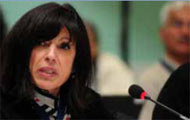
“I’ve traveled the coastline and whenever I jump in my boat I’m taking a risk.”
James Pokiak, Alternate Member, Fisheries Joint Management Committee, Tuktoyaktuk, Northwest Territories
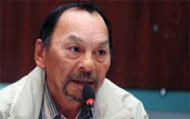
What level of risk is acceptable?
Throughout the Arctic Review, many people told us that when one is faced with great risk, there is great responsibility. While there is much that can be done to prevent an accident from happening, no one can guarantee that there will never be an offshore drilling accident. We heard that offshore drilling, particularly in the Arctic, always comes with risks.
During the Roundtable in Inuvik, we heard participants discuss a concept of tolerable risk.
In the normal course of an application review, we would examine a company’s proposed risk assessment and risk management processes. We would look at the consequences of the risks occurring, notably a worst-case scenario. For instance, we would require an operator to tell us how long it would take to regain well control given the operating environment, such as ice conditions, lack of daylight, and possible weather conditions. The operator would also have to describe the volume of oil that could be released, the volume of oil that would be recovered until well control is regained, and the likely short-term impact and residual longterm impact on the environment and Northern communities. We would weigh all the case-specific information in front of us and make a risk-informed decision to approve or deny the application.
“... what this does mean to us is that when someone says that they’re prepared to take a risk, what they’re really saying is that they’re prepared to suffer the potential adverse effects of the decision in the expectation that that’s not likely to happen and that there are benefits to be had that they want to have.”
Robert Powell, Director, Mackenzie River Basin, WWF, St. Albert, Alberta
“I want to assure you before I even start that we would not undertake any operation in the Beaufort Sea that we did not think that we could manage the risk associated with that project ... I can’t get up here and tell you that I can do anything without risk. There’s a risk inherent in everything we do.”
Mike Peacock, Imperial Oil
From the Filing Requirements
4.10 Risk assessment
Describe the risk assessment and risk management processes with enough detail to demonstrate that the applicant has:
- effective processes in place to identify threats and hazards to safety and the environment, to identify and select effective mitigative measures, and to evaluate and manage the associated risks; and
- taken, or will take, all reasonable precautions to ensure that safety and environmental protection risks have been addressed for the proposed work or activity, including taking into account the interaction of all components, including structures, facilities, equipment, operating procedures, and personnel.
4.18 Spill Contingency Plan
- Describe the consequences of the worst-case oil spill scenario, including:
- the volume of oil that could be released;
- the volume of oil that would be recovered;
- the likely shortterm impacts on the environment and Northern communities;
- the residual longterm impacts on the environment and Northern communities; and
- how long it would take to regain well control in worst-case operating conditions.
Chapter 6: How should we respond when things go wrong?
As stated in the Canada Oil and Gas Operations Act, we are the lead agency for emergencies related to oil and gas drilling and production in the Canadian Arctic offshore. Our role, in the case of an incident or emergency, is to lead a coordinated agency response, monitor the operator’s response activity, and verify that legal requirements, conditions of authorization, and other commitments are followed and met. We investigate and report on the incident to help prevent a similar occurrence in the future.
Our Chief Conservation Officer can authorize any person to take control of the management of the emergency response if a company is not responding adequately to a spill. We have trained emergency management specialists with the expertise to evaluate a company’s emergency response activities and, if required, take over management of the spill response.
How are companies held responsible for emergencies or spills?
Companies regulated by the NEB must anticipate, prevent, mitigate, and manage incidents and oil spills of any size and duration.
Emergency response procedures are required as part of the information to be provided in an application for authorization. As part of our Emergency Management Program, we evaluate and may audit the company’s emergency response procedures during our review of an application for authorization. Our emergency management staff may attend company emergency response exercises and evaluate the operator’s readiness in case of a real incident. We can also verify field operations on-site and inspect safety systems to verify that regulations are met and that all workers are familiar with their organization’s emergency response procedures.
How will information be made public?
Mike Peacock of Imperial Oil told us:
...we believe that safety is not a proprietary subject and we’re going to share our Safety Plans, and we ... categorize oil spill response into a Safety Plan. So we will share that ... if we go forward with our application. We will review all our plans with the community associations and the community groups as part of that process. Even before we submit it to the NEB we’re going to get the communities input on it.
During the Roundtable, there was discussion about the public availability of information to be provided by applicants in a future drilling application since much of the information submitted under the Canada Oil and Gas Operations Act is legally privileged pursuant to section 101 of the Canada Petroleum Resources Act. This means that we cannot make this information public without the written consent of the person who provides the information.
Industry participants agreed to make publicly available any information that is not commercially sensitive or that does not contain personal information.
“I realize that the National Energy Board has the authority to approve or deny deepsea exploration in Canada and with this authority comes great responsibility ... Our Arctic environment is so fragile that any oil spill will have a major effect on the region and entire circumpolar Arctic.”
Amie Charlie, Grade 12 student, Samuel Hearne Secondary School, Inuvik, Northwest Territories
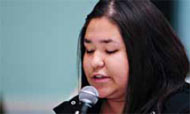
“Yes, certainly we would be willing to release ... our Safety Plan, training plan, ice management plan, Environmental Protection Plan, Contingency Plans ... safety and environmental protection is not a competitive matter. It’s something that we’re looking to enhance the performance across our industry.”
Rod Maier, Chevron Canada Resources
As part of our commitment to transparency, we will expect applicants to file written consent to allow the public release of any information filed with us that is not identified by the applicant as being commercially sensitive and privileged. At a minimum, we will expect applicants to agree in writing to make public their:
- Safety Plans;
- Contingency Plans;
- Emergency Response Plans (if such plans exist separately from other Contingency Plans); and
- Environmental Protection Plans.
We expect applicants to provide reasons why certain information should remain privileged. Information that is not filed pursuant to the Canada Oil and Gas Operations Act will not be legally privileged. Personal information should be removed in accordance with the applicable legislation.
We expect applicants to meet and exceed this expectation as it will support our commitment to hold those we regulate accountable for safety and environmental protection, promote greater information sharing, and help continually improve industry performance.
How will companies be held financially accountable in the event of a spill?
If a spill were to occur, the operator could be found liable for the loss or damage they caused in accordance with the general laws of Canada. In addition, both the Canada Oil and Gas Operations Act and the Inuvialuit Final Agreement hold the operator accountable as they impose absolute liability on the operator. Absolute liability is exceptional in nature and is rarely seen in the legal framework applicable to industrial activities. When absolute liability is imposed, an operator cannot avoid liability on the basis that there was no fault or negligence. In the case of the Canada Oil and Gas Operations Act, this absolute liability is limited to prescribed amounts.
Furthermore, we can pay claims from securities held as proof of financial responsibility. This provides us with the authority to directly pay out claims without waiting for a court to determine fault or negligence. Prior to paying out any claims, we would consider the circumstances of each specific case. Any claims may be sued for and recovered in a court of competent jurisdiction in Canada.
During the course of the Arctic Review, we heard that people from the Arctic rely significantly on harvesting opportunities offered by the ocean and land for their food and their culture. We heard that the loss of these opportunities would challenge the foundations of their way of life.
If an oil spill were to occur in the Arctic offshore, the effects on the environment and animals could be immediate. On the other hand, the potential legal proceedings for compensation could last many years. As a result, harvesters could face significant delays before being compensated for loss or damage, including loss of harvesting opportunities. Any extensive delay could have a dramatic impact on the region and jeopardize the survival of those who rely on the land and ocean.
“My question is to do about transparency and involvement for the public to be able to review technical documents that are submitted as part of the application process to NEB ... what would be allowed to be reviewed by others ... I guess it goes back to the NEB then as far as what measures will the Board take to ensure that Northern participation in the public hearing process is effective ... ”
Mary Tapsell, Government of the Northwest Territories, Yellowknife, Northwest Territories
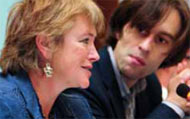
In this context, when determining the appropriate form and amount of financial responsibility for Arctic offshore drilling, we find it desirable that sufficient financial resources be available to address loss or damage, as contemplated in the Canada Oil and Gas Operations Act, and that a portion of these funds be available to quickly compensate people of the Arctic.
We heard that clarity was sought on the Board’s financial responsibility requirements and how it can be demonstrated. We are working on a framework that will outline financial responsibility requirements for all matters and regions covered by the Canada Oil and Gas Operations Act. We will communicate this framework when it is formalized.
In developing this framework, we will leverage the body of knowledge gathered during the Arctic Review process. We will also give consideration to the Guidelines Respecting Financial Responsibility Requirements for Work or Activity in the Newfoundland and Nova Scotia Offshore Areas (the Guidelines). Considering all of the above, the following characteristics can be expected of future filing requirements on financial responsibility for Arctic offshore drilling:
- We will need to have unfettered access to a portion of the funds provided as proof of financial responsibility.
- While each financial responsibility requirement will continue to be decided on a case-by-case basis, we expect that the amounts needed to demonstrate financial responsibility will be higher than those outlined in the Guidelines.
- In the event of a spill, companies will need to clearly demonstrate how estimations of loss of hunting, fishing, and gathering opportunities were used to derive the proposed amount of proof of financial responsibility. This demonstration may include the use of traditional knowledge.
How does an operator respond to an oil spill?
Repeatedly during the Roundtable, we heard speakers from all backgrounds and interests say that the prevention of an oil spill in the Canadian Arctic offshore is the primary goal and desire of all parties. At the same time, the experience of the past tells us to prepare for the worst case. As a part of the information we collected about responding effectively when things go wrong, we commissioned SL Ross Environmental Research to undertake a spill response gap study focused on Arctic conditions in the Beaufort Sea and the Davis Strait. The Department of Fisheries and Oceans also provided studies on oil spill trajectory modeling and a knowledge review of spill effects in the Arctic marine environment.
Spill response is not a one-size-fits-all proposition. We heard information on the universal principle of “tiered spill response”, where the strategy selected to respond to a spill depends, in part, on the size of the spill:
- Tier 1 – equipment immediately on hand for small spills;
- Tier 2 – equipment available from regional sources for larger spills; and
- Tier 3 – national or even international effort required for a very large and long-running spill.
“We believe that we’re going under the IFA (Inuvialuit Final Agreement) and if we can afford to drill in this environment, then we should have the financial strength to fund any cleanup ... We would honor the IFA and all the regulatory requirements that we would have in the unlikely event of an incident.”
Mike Peacock, Imperial Oil
“We have been on this track for a long time and we all know that no one wants a blowout. If for some reason there is, we want timely stoppage and a clean-up and containment program.”
Nellie Cournoyea, Chair and CEO, Inuvialuit Regional Corporation, Inuvik, Northwest Territories
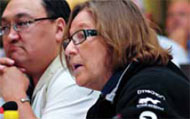
The size and possible duration of a spill becomes a direct factor in choosing how to respond. This was aptly summarized by Steve Potter from SL Ross Environmental Research: “... the sort of strategy that we may use for a small spill doesn’t simply get scaled up when we do a larger spill. It may be a completely different strategy because it may be a completely different requirement.”
The Department of Fisheries and Oceans presented information about the weathering of spilled oil. Weathering involves a combination of biological, chemical, and physical processes that occur when oil is exposed to the natural environment. The environmental conditions and chemical properties of oil and water influence not only how effective a spill clean-up strategy can be, but also influence biodegradation, the process where naturally-occurring bacteria break down the oil. These factors would be taken into consideration when designing spill response strategies.
How well will spill countermeasures work in the Arctic?
There are three spill countermeasures likely to be used in the Arctic offshore.
Containment and recovery involves containing the oil spilled in one concentrated area using booms. Oil and emulsified oil is recovered by skimming it off the water’s surface. This process is not practical for very large spills and, in remote areas like the Arctic, storing, moving, and disposing of collected oil and water would be difficult.
In-situ burning may require the use of a fire-resistant boom or chemical herding agents to contain the spill in a limited area, increasing the depth of the oil layer. Oil is then ignited and burned off the water’s surface. This may offer some advantages in moderately icy environments, as the ice could act as natural containment barriers for the oil.
Dispersant application involves spraying dispersants on oil slicks from fixedwing aircraft, or injecting them directly into a subsea oil plume to disperse or break down the oil into many smaller droplets that are more readily biodegraded.
The success of an oil spill response in the Arctic will depend greatly on environmental conditions. Weather, waves, wind, available daylight, ice conditions, cloud cover, and visibility are key factors affecting spill response effectiveness. In the report, Spill Response Gap Study for the Canadian Beaufort Sea and the Canadian Davis Strait, SL Ross defined a “gap” as the percentage of time that a spill response option cannot be implemented due to environmental conditions.
SL Ross analyzed environmental data from representative locations in the Beaufort Sea and Davis Strait. Their findings indicate that response with at least one of the countermeasures options (containment and recovery, in-situ burning, and dispersant application) would be possible for the period when open water is usually present. Open water is usually present July through October in the Beaufort Sea and August through November in the Davis Strait. When open water is not present, active response would have to be deferred until the following melt season.
“And, in fact, the Arctic and oil are not ... new to each other. Oil’s been seeping naturally in the Arctic for eons, and the reason why we don’t see it is because bacteria break it down naturally ... Living organisms are well-adapted to their environment, and oil is nothing new.”
Kenneth Lee, Fisheries and Oceans Canada, Dartmouth, Nova Scotia
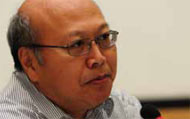
From the Filing Requirements
4.18 Spill Contingency Plan
- Describe proposed improvements or additions to existing infrastructure to support and facilitate the response strategies and manage equipment, material, and human resources.
- Describe proposed new infrastructure facilities to support and facilitate response strategies and manage equipment, material, and human resources, as applicable.
We heard some differing views on the effectiveness of clean-up measures from other Roundtable participants. However, the overall message was clear: the unique Arctic environment will dictate when and how effectively a response to an oil spill can be mounted.
The input we have received on the fate and effects of oil and the effectiveness of spill countermeasures will increase our collective understanding of emergency response requirements for Arctic offshore drilling. Applicants must satisfy the Board that all of these elements, and state-of-the-art capacity in addressing them, have been considered and brought forward as a part of an application to drill.
What infrastructure is required to respond to a spill?
The absence of offshore spill response infrastructure reflects the fact that there is currently no Arctic offshore drilling activity. With the exception of the Devon Paktoa C-60 well drilled in shallow water in the winter of 2005-06, no offshore wells have been drilled in the Canadian Arctic since the late 1980s. Spill response infrastructure currently consists of Canadian Coast Guard Arctic community packs containing basic spill control equipment for near-shore vessel spills. The Mackenzie Delta Spill Response Corporation is equipped to respond to spills in the Mackenzie River Delta.
The Canadian Arctic has far fewer communities than the Gulf of Mexico, and they are smaller and more remote from a global spill response framework. The unique Arctic environment will present significant challenges for spill response. As Larry Triggatti of the Canadian Coast Guard said, “Trying to deploy in the remote environment is one of the major challenges ... that will put the onus on proponents, shippers, and people who deal in the Arctic; and that is a huge challenge”.
We recognize that there will need to be spill response infrastructure in place, with trained and competent responders. Many people from Northern communities expressed their concerns about spill response. We heard comments about their desire to play a meaningful part in spill response and about the need for proactive and timely training before drilling starts. We heard industry representatives acknowledge Northerners’ concerns and commit to engaging communities in more meaningful ways, as early as possible in their planning processes. Industry representatives also spoke of developing and offering appropriate training opportunities to Northerners to help prepare them for employment and business opportunities.
Any applicant will need to demonstrate to us that adequate oil spill response infrastructure will be in place to respond to and mitigate the environmental impacts of a worst-case spill. The applicant will need to address emergency response training for first responders.
“... the North is a really big place. Just last night I was asked to provide a map, which I had done before, which showed Nunavut, since that’s my speciality, overlaid on a map of Europe. And when you do that you don’t see very much of Europe left ... to use the example of Europe, if you have an oil spill off Norway, you have to run down to Egypt in order to pick up some basic supplies ... As several people have mentioned, you can’t afford to wait to bring it in. Even something in Inuvik or Tuk is not going to be of much use if something happens off Clyde River.”
Keith Morrison, Nunavut Tunngavik Inc., Cambridge Bay, Nunavut

From the Filing Requirements
4.18 Spill Contingency Plan
- Describe the training qualification requirements, or competency measures, for personnel and the proposed scope and frequency of the field practice exercises of oil spill countermeasures under Arctic conditions.
- Identify any responder roles and response equipment and training, such as shoreline cleanup assessment technique, that may be provided to Arctic communitybased responders.
Emergency Response Training: What We Heard
Ethel-Jean Gruben, Inuvik Community Corporation, Inuvik, Northwest Territories: “... our people have always expressed an interest in training and development ... and if a disaster ever happens in the Beaufort Sea, the last thing we want to see happening is us standing on the sidelines waiting for people to come from the South to clean up this mess that we gave approval or we supported. And our kids are going to be standing there watching us, saying, you know, Mom, Dad, is this what we agreed on? And it’s not and the humility that we will be feeling because we don’t have the knowledge base and the training to help clean up the mess that we’ve actually given permission to go ahead.”
Rod Maier, Chevron Canada Resources: “... when we talked about training, that would be coming in early, meeting with the local communities, understanding what capabilities exist within the communities ... what existing equipment and contracting opportunities exist within the communities, looking at training, identifying gaps and educating and consulting early to be able to understand and ensure that there’s comfort with our approach with respect to the oil spill plans ... a key learning that we’ve taken away from this week is that we need to do that earlier than we have done in the past. We certainly have to broaden our aperture and our perspective and I think be more creative than we’ve been in the past in terms of engaging the communities and looking again for training and for business development opportunities. And again, that’s something that we would support as a fundamental principle going forward.”
Gary Sykes, ConocoPhillips Canada: “... our policy is just to engage in consultations as early as we possibly can. You know, the sooner you begin that consultation process, the more benefit. And I think in that context ... Contingency Plans ... or our emergency response capability is something that’s going to come up very early in the discussions, and that’s a good thing because it gets the dialogue going early. So we don’t see any downside to beginning those consultations as soon as we possibly can and beginning those conversations.”
Mike Peacock, Imperial Oil: “Anything we do has got to be done in a safe manner. We can’t put any responders at risk. Therefore, we have to do a full assessment of the incident, and each incident would be different, but we couldn’t put people at risk, so a full assessment before the operation starts is critical.”
Eugene Pascal, Councillor, Hamlet of Aklavik, Northwest Territories: “... we are the first responders, we are the people who are out there, we are the ones who are going to be affected if anything happens, and you know, if we are affected we are going to do a good job just to make sure that its recovered properly.”
Frank Pokiak, Chair, Inuvialuit Game Council, Tuktoyaktuk, Northwest Territories: “... since the communities are going to be the first responders, when is the training going to start taking place?”
Brian Love, Government of Yukon, Whitehorse, Yukon: “We can’t compromise safety in terms of ... operations. We’re not asking companies to hire people that aren’t certified, so it’s a joint responsibility.”
Mike Peacock, Imperial Oil: “What I’ve heard over the last couple of days is a need for us to go away and think about how we can maybe improve on that and get some more information out earlier than perhaps we have done in the past on potential training opportunities. Certainly as I mentioned before, on some of our programs that we’ve already executed we have provided employment opportunities and training opportunities for the Inuvialuit on the 3D Seismic Programs that we’ve had, on the ice trials that we’ve had. And hopefully as we start to progress these opportunities that we have, additional training opportunities will be created and made available for the Inuvialuit.”
Chapter 7: The journey continues
The Arctic Review process was a journey we embarked on to discuss the safety and environmental requirements for offshore drilling in Canada’s Arctic. It has been a rewarding journey and it is not yet over. Much has been accomplished in the course of the Arctic Review and much remains to be done.
Many people joined us in this discussion; we carry with us their voices. As we prepare for the future, we will work collaboratively with land claim organizations throughout the North and continue to listen to those who will be most affected by offshore drilling in the Arctic. We will pursue opportunities to strengthen our regulatory framework in support of future Board decisions on Arctic offshore drilling.
As the values and the interests of the public evolve over time, so do our expectations of project applicants. We are committed to continually improving our regulatory processes and to ensuring that decisions on drilling applications will be made in a manner that addresses safety of workers and the public and protects the environment. The companion document to this report is the National Energy Board Filing Requirements for Offshore Drilling in the Canadian Arctic. Future revisions to the Filing Requirements will ensure that our expectations continue to align with the interests of all Canadians.
We are deeply grateful to the many people who shared their expertise and knowledge with us. Thanks to the insight, rigour, and generosity of all who contributed, the Arctic Review yielded a rich foundation of information that has informed the contents of this report and the Filing Requirements.
Gaétan Caron, National Energy Board Chair: “The journey will continue. We will see each other again. We do not know exactly when or where. But on behalf of the National Energy Board, we are giving you our commitment that the dialogue will continue.”
“... one of the key things that I found this week is we’ve probably incorporated about multiple years of consultations in one week this week in terms of what we’ve learned, what we’ve understood and how we’ve shared knowledge together collectively and having everybody within this room to hear it together and to share their views. I mean, it’s gotten us to a place that would have taken possibly decades to get through in conventional means.”
Rod Maier,
Chevron Canada Resources
“Inuit want to be involved in the future of the Arctic. We want to have meaningful consultation. We want to invest in our own future. We want a voice at the table because, after all, we are the people who will be living here ... ”
Okalik Eegeesiak,
President, Qikiqtani Inuit Association, Iqaluit, Nunavut
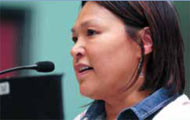
- Date modified:
